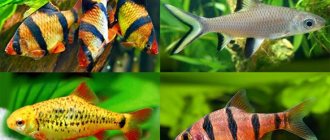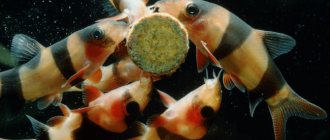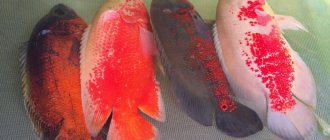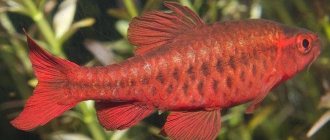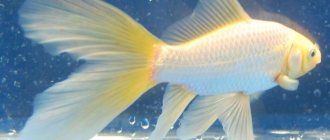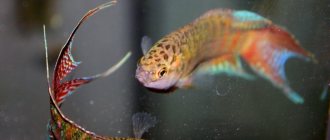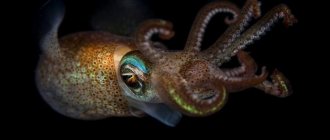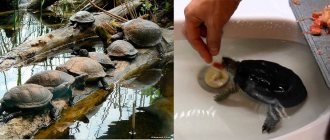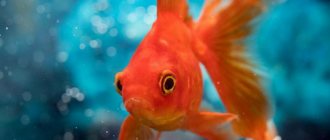Simplicity of content:
Latin name: Xiphophorus maculatus
Lifespan: 4 years
Maximum size: 5 cm.
Average cost: 70-160 rubles.
The aquarium platie fish is one of the most common and sought-after species, as it is distinguished by its unpretentiousness and visual attractiveness. The variety of colors allows you to get a spectacular species aquarium, in which it will be extremely easy to provide comfortable living conditions for your pets. The small size of platies allows them to be kept even in small containers, which is a plus for residents of small apartments.
Motherland
The homeland of platies is America, where they live in the lower reaches of rivers flowing into the Atlantic Ocean. Under natural conditions, these schooling fish have a color ranging from yellowish-gray to spotted. It cannot be called very attractive, and today's bright fish are the result of the work of breeders.
Wild platies have a spotted color, which allows them not to stand out against the background of water and plants. Blue platies (pictured) will not go unnoticed!
Platies grow in nature up to 18 cm, and aquarium forms do not exceed 5 cm in length. Their body is shortened, resembling a diamond, with a fairly wide caudal fin. The head is proportional to the body, with large eyes. The mouth is directed upward. The movements of the fish are moderately fast, smooth, and not jerky.
To live in nature, fish choose places with dense thickets of aquatic plants, where they can hide from predators. The diet consists of algae and insects, as well as small aquatic invertebrates that do not have a strong shell.
These fish were brought to Europe late - only in the 20th century. They were brought from Mexico and Guatemala. The species was first described in 1886. In the USA, the species quickly attracted the attention of breeders, who, through their efforts, were able to obtain from a rather inconspicuous wild fish spectacular inhabitants for home ponds with colors ranging from red to blue, distinguished by their hardiness and even forgiving beginners many mistakes in caring for an aquarium. Platies are peaceful and can get along well with a large number of other fish species.
Description
Platies are small fish, their body length can reach 5 cm. They live for about 3-4 years, provided optimal conditions are created for them. As for the color and appearance in general, it is impossible to describe everything - there are more than 30 species of these fish, and more than 120 color options.
The aquarium fish platylon balloon deserves special attention. This is a selective species, unlike other platies. Their body is round, swollen, which was obtained in the process of crossing with fish with a short spine. The fry are born with a normal spine, but during growth it becomes deformed. These fish are more capricious compared to other species.
The most common species is the red platie - these fish are unpretentious. Many breeding forms were created on their basis. Slightly less known are black platies, with bluish or greenish scales. Multi-colored platies are incredibly beautiful - their body shimmers with all the colors of the rainbow.
The disc platy has a shortened and flattened body. These fish were also obtained through crossing.
Origin story
Platies are the name given to a number of fish species that belong to the carp-toothed family. Aquarists around the world favor platies, however, in most cases they call them “mollies.” At the very beginning, this term referred only to melanistic forms of platies, but later the entire series of platies species began to be called in this way.
Just like guppies, platies are often bred. By the way, these fish appeared in Europe back in 1907, due to the fact that they were brought from Guatemala and Southern Mexico. In the wild, platies live in the lower reaches of rivers that flow into the Atlantic Ocean. However, the coloring of fish in their natural environment is much less attractive than that which is typical for the inhabitants of domestic ponds. Often the fish are distinguished by a brownish-yellow color, which is slightly enlivened by a couple of dark spots located in front of the caudal fin. Today, the results of many years of breeding have proven that platies, while maintaining their shape, have a wide variety of colors.
Like almost all viviparous species, platies are extremely unpretentious and easy-going. They can be kept in small aquariums, from 40-50 liters, but larger is better. They do not show aggression among themselves (unlike swordtails), and they can be kept with a predominance of females. One male is enough for two or three females.
Water parameters are not too important, water of medium hardness will be ideal (15 - 30 dGH), acidity within ph: 7.0-8.3, and water temperature 22-25 C. It is important that the water is clean and fresh, it is advisable to change part of the water weekly ( up to 20%). Filtration and aeration are desirable, but if the aquarium is not overcrowded, then it can be neglected.
Characteristic
Platies are warm-water fish. The coloring of aquarium species of platies, thanks to many years of selection and comfortable conditions of detention, is distinguished by brightness, richness and a greater variety of colors than that of the ancestors of fish of this genus. Their wild relatives are brownish-yellow in color, with two prominent dark spots in front of the caudal fin.
Fish of the platie genus are small in size: the body length of males is less than that of females - from 3 to 4 cm and from 4 to 6 cm, respectively. The body is quite dense, strong, the caudal fin is wide and strong, although as a result of selection experiments, individuals with various shapes of the body and fins were bred. For adult males, in addition to their size and slimmer body, a characteristic feature is the copulatory organ (gonopodium) - an anal fin rolled into a tube.
Structure and appearance of platies
The fish are small in size. In an aquarium they can grow up to 5 cm in length. The body is shortened, the caudal fin is quite wide. In nature, the natural color of platies is not very bright - the main color is yellow-brown, and there are two dark spots near the tail. However, thanks to breeding work, there is a wide variety of colors in aquarium platies - these are red, yellow, black, spotted, etc. It was also possible to breed breeds with a changed shape of the body and fins, for example, balloons (curved spine and rounded protruding abdomen), veiled platies ( They are characterized by an elongated dorsal fin).
Differences between platies and mollies
All subspecies of platies and molly have a fairly similar appearance. Thus, mollies have a more elegant and toned body, and the distance from the anus to the caudal fin is greater. There are not as many color options as there are for platies - usually black and gold mollies are on sale, and in rare cases white.
Molly is more graceful.
Platies are calmer and do not get into fights with their neighbors. This can also be regarded as a distinctive feature. Their faces have different expressions - molly's is more aggressive.
When starting an aquarium, you can safely choose any poeciliids as your first pets. They are distinguished by good health, endurance and will survive even some deviations from ideal conditions. In addition, they reproduce easily, they can live in a home pond from generation to generation, and the peaceful nature of these fish allows them to be introduced to attractive neighbors and some other species.
Habitat of platies
The natural habitat of platies is water bodies in Central America (Guatemala, Mexico) and the southern part of North America (US states of Florida, California, Colorado). This is a freshwater fish, but it has also managed to adapt to life in water with high salinity. Therefore, it can be found at the mouths of rivers that flow into the Atlantic Ocean. Fish prefer areas of biotopes with muddy soil and dense thickets of plants. The habitat of the most attractive individuals in appearance is the Yucatan Peninsula.
Diseases
Possessing good immunity, platies rarely get sick. However, violations in maintenance parameters can lead to infection of fish by parasites and fungi.
Fin rot
A dangerous disease that begins with damage to the fins and spreads its negative impact to the internal organs of the fish. External signs of rot:
- fins sticking together;
- gray ulcers;
- tissue necrosis.
The main prevention of the disease is careful adherence to sanitary standards.
Ichthyophthiriasis (semolina)
The infection is marked by a small white rash on the body , similar to semolina. Often enters ponds with dirty food. Successfully cured with malachite greens.
Nematodes
Worms rarely affect platies , but to avoid infection, antiseptics should be regularly added to the water, observing the required dosage.
Popular varieties of aquarium platies
Pecilia Mickey Mouse
The main body color of this type of fish can be very different - from blue, red to golden shades. Their main feature is the spots located at the base of the caudal fin. There is one large black spot and two small ones on the sides. Their arrangement resembles the silhouette of the head of Mickey Mouse, a cartoon character. This similarity gave the species its name. The size of the fish is 5-7 cm.
Pecilia black
The main body color of the fish is black. However, platies are never completely black. Lighter colors from red and orange to golden yellow are present on the tail, fins, and in the head area. The size of representatives of this species is 5-7 cm.
Pecilia red
These fish are completely red in color, including the tail and dorsal fin. Some people mistakenly attribute this species to fish with a red color but a black caudal fin. In fact, this is not correct, since such fish belong to a different species. And the red platie is completely red. Representatives of this species reach a size of 5-7 cm.
Pecilia white
The body color of the fish has no colors other than white. During the selection work, it was as if the genes responsible for the color pigmentation of the body were “turned off”. Red gills and internal organs are sometimes even visible through the scales. But at the same time, the fins may differ in color from the body. This is a very rare species, since the phenotype is almost not transmitted to offspring. The size of the fish is 5-7 cm.
Pecilia blue
The body of the fish has a bluish coloration with a very impressive neon or metallic tint. Iridophores are responsible for this cell coloration. An adult reaches a size of 5-7 cm.
Pecilia balloon
This type of fish is distinguished by its unusual body shape. It is shortened and has a curved spine. The fish has a protruding rounded belly, and the entire body shape is almost round. There are many color variations of cylinders. Due to their shape, the fish are a little clumsy, so it is not recommended to choose very active fish as neighbors for them. The size of representatives of this species is 5-7 cm.
Diseases
With good care, a balanced diet and proper maintenance, diseases of the platie are rarely bothered, otherwise the pets may develop diseases characteristic of the genus:
- Melanosis is a disease that occurs due to a malfunction in the fish’s body when there is a high production of melanin. Symptoms appear as spots on the body, which over time develop into lumps or lumps. Sick fish are moved to quarantine tanks, where they follow a strict regime.
- Tumors are a collection of bacteria on the body of the phenotype that look like lumps. Pets are treated with saline solution: 20 g of salt per liter of liquid. Sick fish are dipped in the solution and kept for ten minutes, after which they are placed in a separate tank until the signs of the disease disappear.
- Dark blisters are a characteristic ailment for phenotypes, accompanied by the appearance of dark-colored blisters on the body. To cure a pet, the fish is treated with the antiseptic Tripaflavin, followed by a stay in quarantine until the disease subsides.
Platies are friendly aquarium fish that have conquered the world thanks to the abundance of varieties of different shapes and colors. Care and maintenance do not require much effort and time, and the pets themselves have funny behavior, are active and hardy, and also look great in artificial reservoirs among green, dense vegetation.
Conditions for keeping platies
Platies are unpretentious fish, but in order for them to feel comfortable, be healthy and reproduce well, care must be taken to create suitable conditions. In comfortable conditions, in captivity, life expectancy is 3-4 years.
Aquarium volume
The size of the aquarium should be selected based on the calculation: at least 15 liters for one pair of platies. These are schooling fish, it is recommended to keep them in groups of at least 6 individuals. Therefore, the volume of the aquarium should start from 60 liters. It should also be noted that they are quite prolific. The aquarium must be equipped with a lid, since platies are active and can jump out.
Light
For the fish, natural daylight will be enough, without direct sunlight. But if the aquarium is in a shaded area, then it is recommended to install a small lamp. It is also necessary to take into account the presence of plants in the container, adjust the lighting intensity specifically to them, creating shaded areas for the fish.
Water requirements
It is necessary to saturate the water well with oxygen. It should be quite hard, because in soft water the fish become more vulnerable to diseases. Optimal parameters: temperature 24-27°C, total hardness 10-20° dGH and pH up to 8. Water changes are carried out once a week in the amount of about 20-30% of the total volume of the aquarium.
You should be very careful when adding salt to the water. Beginner aquarists should generally refrain from using salt! Experienced aquarists can periodically use salt for medicinal and preventive purposes, provided that the species aquarium or its other inhabitants also tolerate increased salinity well.
What should the soil be like?
It is better to choose a dark-colored soil, and adding marble chips to it will help to slightly increase the hardness. The granule sizes are 3-5 mm, so that it is convenient to plant plants, without sharp edges. It is better to choose specially prepared aquarium soils.
Vegetation and scenery
Since in natural conditions fish live in areas with dense vegetation, it is recommended to create similar conditions in the aquarium. Islands of dense thickets must be present. To create them, you can use hornwort, cryptocorynes, elodea, echinodorus and other lush plants. And Riccia thickets will be an excellent shelter for fry. But don’t forget that you need to leave enough space for free swimming.
Equipment
Standard: Filter (external or internal, depending on the volume of the aquarium), thermostat - against a sharp drop in temperature or if the room is cool, thermometer, aerator - as necessary.
Reviews
I love platies for their peaceful nature and variety of colors. The nimble fish are not difficult to care for. I started them as my first inhabitants of the aquarium and have been faithful to them for 5 years. Elena, 40 years old, Tula
The child had been asking for an aquarium for a long time, and when they decided, they set up a 60-liter container and introduced 8 platies (4 red and 4 spotted). No one had ever kept fish before. It turned out to be not difficult - just change the water regularly and feed it. In the year we’ve been keeping them, we’ve already managed to get fry several times. Beautiful and simple fish. Nikolay, 30 years old, Moscow
Feeding
This type of fish is omnivorous. In nature, platies feed on small insects and algae. Fiber is an essential component of their diet, as it is necessary for good functioning of the gastrointestinal tract.
If you keep your platie in an aquarium, food in the form of flakes, sticks, granules and even tablets are perfect. Live and frozen include: artemia, bloodworms, tubifex, aulophorus, enchytraeus, coretra, daphnia and all those that are suitable in size. Also, in addition to regular protein feeds, it is necessary to provide vegetable feeds. If there are few plants and decorations in the aquarium where algae settle, which readily eat the platies, feeding with plant foods is mandatory.
Portions should be small so that the fish eat them in a few minutes. Ideally, dry food should not sink to the bottom at all. Feeding is carried out 1 to 2 times a day. Don't forget about fasting days - once a week. On this day, the fish are left to their own devices in terms of feeding, combing the aquarium in search of food.
Nutrition
Inhabitants of natural reservoirs eat insects and vegetation. Their aquarium relatives are also unpretentious and can eat almost any food. Owners should consider that their pets should receive plant foods rich in fiber:
- cereals containing plant components;
- pieces of boiled vegetables - cucumbers, spinach, zucchini.
Such food makes up the lion's share of the diet of wild platies; it is necessary for the full functioning of the gastrointestinal tract of the fish. Animal food is also included in the menu - these can be live or frozen bloodworms, brine shrimp, and correts.
Compatibility
Peacefulness is one of the advantages of platies. They are able to get along well not only with their relatives, but also with fish of other species. The most favorable neighborhood will be with such “roommates”: swordtails, guppies, iris, mollies, and some catfish. Possible proximity to gouramis, barbs, tetras, and angelfish. Provide sufficient hiding places in the aquarium.
Absolutely incompatible with aggressive carp, astronotus, as well as cold-water fish (golden, koi carp, etc.).
Caring for fry
If the fry are raised in a separate aquarium - without adults, they need certain care. Care must be taken to create a favorable habitat for the young and feed them properly.
How to take care of the fry:
- change the water in the aquarium once every 3 days or more often;
- maintain the temperature in the range of +25…+27 °C;
- install a filter with a fine mesh to prevent the fry from being sucked inside;
- feed the young animals 5-6 times a day with small amounts of food.
What to feed the fry:
- at the start, you can use adult food, ground into dust, or specialized food for fry;
- feed the young animals with microplankton, nematodes, cyclops, and brine shrimp;
- Feed the grown fry with aulophorus and small daphnia.
Features of breeding and reproduction of platies
Platies are viviparous fish and, like all viviparous fish, they have distinct sexual characteristics. Females are less colorful in color and larger in size, their abdomen is more rounded. Males are not only much smaller than females, but also more colorful; the most important difference is the gonopodium they have. This is an organ that allows females to be fertilized - it serves as a kind of gutter through which reproductive products enter the female’s abdomen. And to make it easier for the male to stay near the female during fertilization, there is a special hook at the end of the gonopodium.
Manufacturers' choice
Since the sexual characteristics of platies are clearly expressed, choosing a pair for breeding is not difficult. Puberty occurs at the age of 5-6 months. You should select the most beautiful, largest and healthiest individuals if you plan to remove them from a community aquarium. But in fact, depositing at the stage of fertilization and maturation of eggs in the female’s abdomen is not necessary. The ripening of eggs lasts about 1-2 months. When the female is ready to spawn, her spot next to the anal fin becomes darker, and her abdomen takes on a rectangular shape. There may not be any darkening on the belly, near the anus, it all depends on the color of the female.
not pregnant female livebearer
pregnant female livebearer
Spawning conditions
A female can give birth to up to 100 fry. It all depends on her age and size. Jigging a fertilized female will help preserve the offspring as much as possible. There is no need to create any special conditions in the spawning area. Water will come from a community aquarium, plant a few small-leaved plants that will serve as shelter for the fry and take care of filtration, aeration (an airlift filter will help) and water changes.
Spawning process
The process is standard for all viviparous fish. Already formed fry are able to immediately feed on their own. After spawning, it is recommended to immediately return the female to the general aquarium so that she does not eat her offspring.
Adviсe
- If overfeeding occurs, immediately remove excess food from the aquarium with a net.
- When purchasing fish food, carefully study the expiration date and storage conditions. Avoid loose feed.
- When breeding fish, select fish of the same variety, so the offspring will be purebred.
- When spawning, remember that a lot of offspring appear. Make sure you have a large aquarium.
- When buying pets in a store, carefully inspect the fish. She should not show signs of illness.
- New fish should be introduced into the aquarium gradually. First, place the bag in the aquarium for half an hour, then pour some aquarium water into the shipping bag. Gradually add aquarium water.
Pecilia is a beautiful and unpretentious fish that is perfect for beginners. An interesting feature: if the conditions of detention change sharply, the fish changes sex. Thus, the female becomes a male.
Previous
FishFire barb - a fish for beginners
Next
FishIs it possible to have a fish like a blue dolphin in an aquarium?
